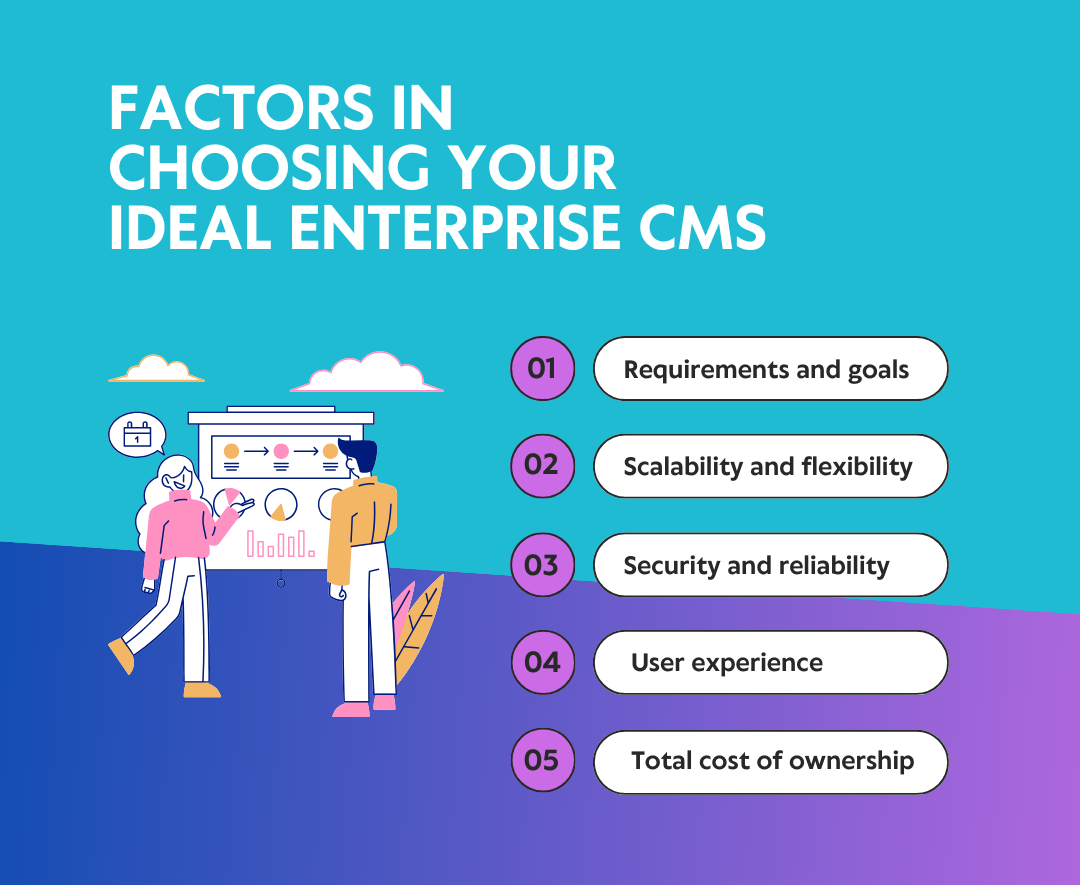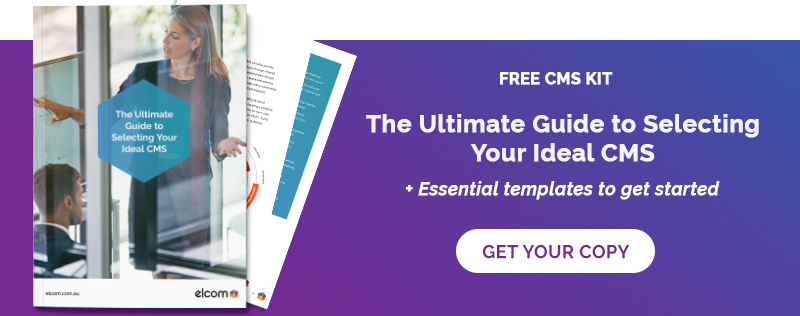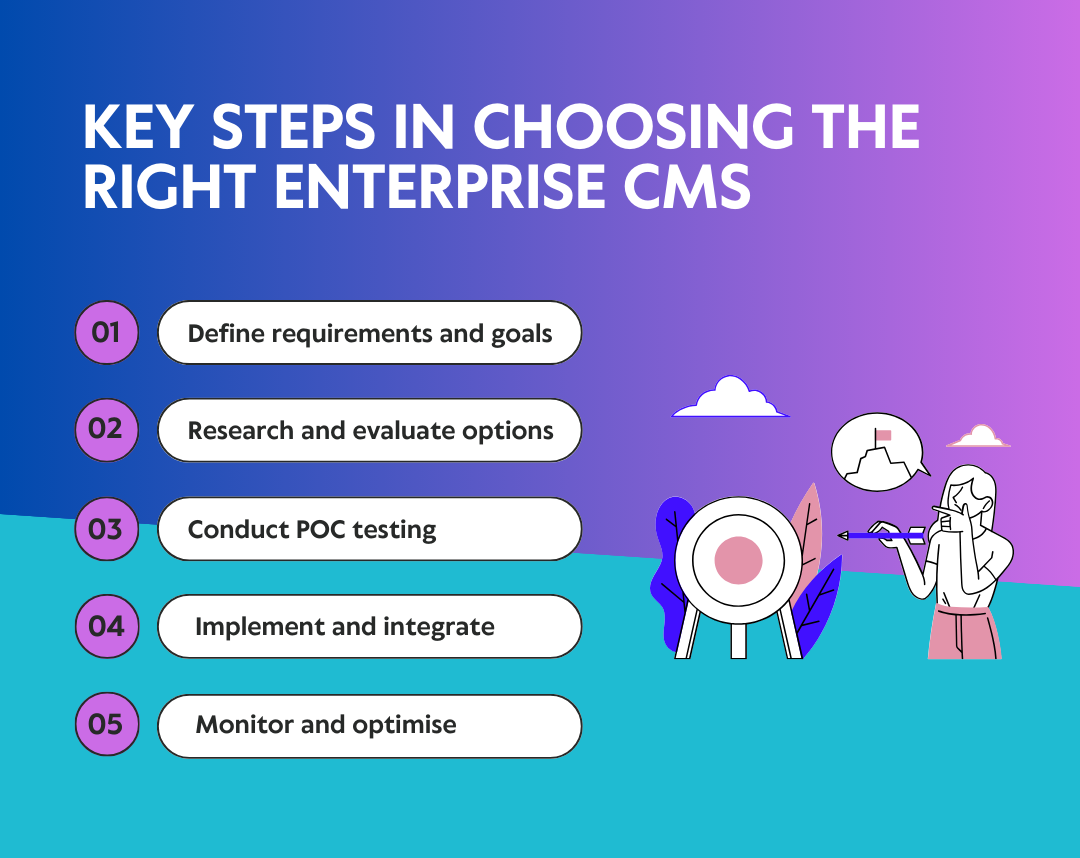Did you know an Enterprise Content Management System (CMS) is a pivotal decision for any organisation? This choice can significantly influence not only the efficiency of your operations but also the effectiveness of your customer engagement strategies.
With all the options available, understanding how to choose the right CMS becomes a critical task for businesses aiming to stay ahead in a competitive market.
Selecting the best CMS for enterprise websites, portals, intranets and other solutions involves more than just comparing features and pricing. It requires a deep dive into understanding your organisation's unique needs, future scalability, and the potential for integration with existing systems.
You want to select a long-term partner for your digital journey – one that aligns with your business objectives and enhances your team's capabilities.
In this guide, we will explore key considerations and practical tips to help you find the best fit CMS for your organisation including how to choose a enterprise CMS.
Why Choosing the Right Enterprise CMS is Crucial
Figuring out how to choose the right CMS goes beyond mere content management; it's about finding a platform that aligns seamlessly with your organisational goals and objectives. It should act as a catalyst for digital transformation, enabling businesses to adapt to the evolving digital landscape efficiently.
The significance of this decision is highlighted by the fact that the global enterprise content management market size is expected to reach USD 43.16 billion by 2028, growing at a CAGR of 10.8% from 2021 to 2028. This growth underscores the increasing reliance of organisations on sophisticated CMS platforms to manage their digital content effectively.
A well-chosen CMS can revolutionise how an organisation communicates internally and engages with its customers externally. It ensures that content is not only created and managed efficiently but also delivered in a personalised and contextually relevant manner. This is crucial in an age where customised user experiences are the norm, not the exception.
In addition, the best CMS for enterprise websites offers scalability and flexibility, allowing businesses to expand and adapt their digital presence as they grow. It should integrate seamlessly with other tools and systems, forming a cohesive digital ecosystem that drives operational efficiency and innovation.
Failure to choose an appropriate CMS can lead to increased costs, reduced productivity, and a disjointed customer experience. It can also hinder an organisation's ability to respond swiftly to market changes, putting them at a competitive disadvantage.
Related reading: Complete Guide to Enterprise Content Management Systems
Factors in Choosing Your Ideal Enterprise CMS
When it comes to selecting an enterprise CMS, several key factors must be considered to ensure that the system aligns with your business needs and objectives.

Here’s a breakdown of the essential elements to consider:
1. Business Requirements and Goals
The first step in choosing a CMS is understanding your business requirements and goals. What are your primary objectives? Are you looking to improve internal communication, enhance customer engagement, or streamline content management processes? The best CMS for enterprise websites should align with your specific business goals, whether it's increasing sales, boosting customer engagement, or improving operational efficiency.
2. Scalability and Flexibility
As your business grows, your CMS should be able to grow with it. Scalability is crucial in ensuring that your chosen system can handle increased traffic and content without compromising performance. Flexibility is equally important; the CMS should be adaptable to changing business needs, allowing for the integration of new features and technologies as required. This ensures it remains relevant and effective over time.
3. Security and Reliability
In an era where data breaches are increasingly common, security cannot be overlooked. Your CMS must have robust security features to protect sensitive information. This includes secure access controls, regular security updates, and compliance with relevant data protection regulations. Reliability is also key; the CMS should be consistently available and performant, minimizing downtime which can affect both internal operations and customer experience.
4. User Experience
The CMS should offer an intuitive and user-friendly interface for both your content creators and your audience. For content teams, ease of use in content creation, management, and publishing is vital. For your audience, the CMS should enable a seamless and engaging user experience across all digital touchpoints.
5. Total Cost of Ownership (TCO)
Finally, consider the Total Cost of Ownership, which includes not just the initial cost of the CMS but also ongoing expenses such as maintenance, support, and upgrades. A CMS with a lower upfront cost might end up being more expensive in the long run due to additional fees and operational costs. It’s important to evaluate the TCO to ensure that it fits within your budget while still meeting all your business needs.

Key Steps in Choosing the Right Enterprise CMS
Choosing the right CMS is a process that requires careful planning and execution.
Here are the key steps to ensure you make an informed decision in detail:

1. Define Requirements and Goals
Deciding on the best fit CMS for an organisation begins with clearly defining what you need. This involves understanding your business objectives, the challenges you are facing with your current system (if applicable), and what you aim to achieve.
Consider factors such as the type of content you will manage, content personalisation, the level of customisation required, user roles and permissions, and integration with other systems. Setting clear requirements and goals will guide your selection process and help you find a CMS that aligns with your business strategy.
Here are some examples:
Content Management Needs
- Requirement: A user-friendly interface for non-technical staff to easily create, edit, and publish content.
- Goal: Streamline the content management process to increase productivity and reduce the need for IT intervention in day-to-day content updates.
Customisation and Flexibility
- Requirement: High customisability to tailor the CMS according to specific workflow and branding requirements.
- Goal: Create a unique and branded online presence that can evolve with changing business needs.
Security Features
- Requirement: Robust security measures including access controls, encryption, and regular security updates.
- Goal: Protect sensitive content and user data, ensuring compliance with data protection regulations.
Mobile Responsiveness and Accessibility
- Requirement: A CMS that supports mobile-responsive design and adheres to web accessibility standards.
- Goal: Provide an optimal user experience across various devices and ensure inclusivity for all users.
2. Research and Evaluate Options
With your requirements in hand, begin researching the various options available. Look for systems that are well-suited to your industry and business size. Evaluate each option based on how well they meet your defined requirements, as well as the ROI on each CMS.
This stage may involve reading reviews, studying product documentation, comparing features and pricing.
Request demonstrations from vendors to see the CMS in action. This can give you a feel for the user interface and workflow. If possible, use a trial or sandbox version of the CMS. This hands-on experience is invaluable in assessing whether it is user-friendly and meets your functional requirements.
Understand not only what the CMS offers now but also the vendor’s commitment to future development. A roadmap of planned features and updates can indicate the vendor’s dedication to evolving with technological advancements and customer needs.
Remember to consider both the current capabilities and the future roadmap of the CMS platforms.
3. Conduct Proof-of-Concept (PoC) Testing
Before making a final decision, it's advisable to conduct a Proof-of-Concept (PoC) test.
This involves creating a small-scale implementation of the CMS to evaluate its functionality and compatibility with your existing systems.
This might involve setting up a basic site structure, uploading some content, and integrating with a few key systems.
PoC testing helps identify any potential issues and assess the ease of use and performance of the CMS in a controlled environment. This includes content creation and management, user role configurations, and integration capabilities with existing systems like CRM or analytics tools. Also, pay attention to aspects like load times, responsiveness, and any glitches or bugs.
4. Implement and Integrate
Once you have selected a CMS, the next step is implementation and integration.
This involves installing the CMS, configuring it to meet your specific needs, and integrating it with other systems and technologies in your digital ecosystem.
Start by creating a comprehensive plan that outlines every step of the CMS implementation. This plan should include timelines, resource allocation, data migration strategies, and any custom development requirements.
Tip: Migrating content and data to the new CMS can be one of the most challenging aspects. Ensure that data is backed up before migration. Plan for a methodical transfer of content, keeping in mind the structure and format changes that may be necessary in the new system.
Consider implementing integrations in stages if you need to work to a tight deadline.
Ensure that this process is managed carefully to minimise disruption to your operations and consider implementing your new enterprise website outside of peak website usage times.
5. Monitor and Optimise
After implementation, continuous monitoring and optimisation are crucial.
Regularly check the system’s performance to ensure it is running smoothly and efficiently. This includes monitoring speed, uptime, and responsiveness.
Collect feedback from users regularly to understand their challenges and needs. This feedback is crucial for making iterative improvements to the system. Use this information to make adjustments and improvements.
Keeping your CMS optimised ensures that it continues to meet your evolving business needs and provides the best possible experience for your users.
And remember to stay updated with the latest versions of the CMS! Regular updates can provide new features, security enhancements, and performance improvements.
The Role of Enterprise CMS in Customer Experience
An enterprise CMS plays a crucial role in shaping the customer experience (CX), acting as the backbone of your digital marketing strategy. It not only streamlines content creation and management but also ensures that the right content reaches the right audience at the right time.
According to a report by Forrester, 72% of businesses say improving customer experience is their top priority.
A robust CMS empowers organisations to create, manage, and optimise customer-facing content with agility and precision. This is essential in an era where personalised content and seamless user journeys are key drivers of customer satisfaction and loyalty.
Furthermore, the choice of a CMS has a direct impact on operational efficiency. Delivering more consistent and engaging customer experiences means that teams can rapidly deploy content that resonates with their audience. Therefore, understanding how to choose a CX platform that complements your enterprise CMS is crucial in building a cohesive and customer-centric digital ecosystem.
Conclusion
The journey of selecting the right enterprise CMS is a strategic one, requiring careful consideration and alignment with your business's long-term goals.
A CMS is a foundational component of your digital strategy, directly impacting customer experience, operational efficiency, and ultimately, business success.
Need more assistance selecting the right CMS for your needs? Check out 'The Ultimate Guide to Selecting Your Ideal CMS'. Developed by experts, this guide is your essential resource for selecting and implementing the ideal CMS for your needs. It comes packed with ready-to-use templates for content audits, migration, and implementation plans, setting you up for success from day one. Simply fill in the form below to receive your copy.

Related resources: